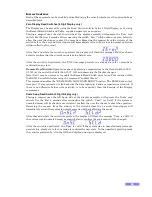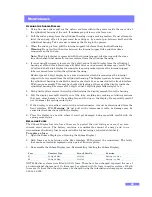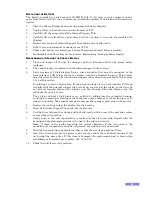
28
3.
When the connection is configured, Hyper Terminal should open the RS232 serial
communications port automatically. The current display value will be shown on the
Command Console terminal, eg 000000. The display must be active, i.e. there is enough
light falling on the display if the light sensor is enabled.
4.
Hit return, type “hello” and hit return again, this should start the Command Console
display. Diagnostic data is displayed, together with all programmed parameters. If not try
again.
5.
The user can monitor the system from the continuously updated display. Hitting return
every minute or so will prevent the console display “Listening Timer” from timing out.
6.
To change any system operating options, first type the user password ‘letmein’ followed
by return.
7.
Any required configuration changes can now be made using the commands described
below.
NOTE:
The console display “listening timer” will time out after 2 minutes of keyboard inactivity.
To re activate the console, press ‘return’ a couple of times and the console display will refresh.
Type the user password ‘letmein’ and press ‘return’.
The password is valid for another 2 minutes after the last keyboard activity once entered.
The console is ‘case sensitive’ and all inputs should to be entered in lower case.
RS232
D
ATA
O
UTPUT
After the console display has timed out, the RS232 output reverts to broadcasting the displayed
value.
Note that if the light sensor is enabled, the RS232 string will not transmit whilst the display is
turned off due to lack of ambient light.
RS232 Serial Data Format
The bit rate is determined by the baud rate setting, which can be changed using the commands at
the console. The default speed is 19200. Each byte is ASCII coded Decimal with 8 bits, no parity
and 1 stop bit. Each data frame is terminated by the carriage return character 13d (0x0D). No
handshaking is available.
The frame has a fixed data length (n characters). Specifying the numerator through the ‘pnum’
command determines the position of the decimal point. If no decimal point is the required option,
then the data frame is padded with an extra ‘0’ in the position of the most significant digit.
One exception to the numeric display, is the case when the count becomes overloaded, i.e. the
displayed count is 1 more than +/-9999. In this case the data frame will be “_ERROR”.
Examples of the output string where ‘¶‘ represents the CR character:
+09999¶
+99.99¶
000000¶
-9.999¶
_ERROR¶
D
UAL
D
ISPLAY
RS232
S
ERIAL
D
ATA
F
ORMAT
If the unit is a dual 4 digit display type, then both readings are output separated by a comma,
count value followed by strain gauge value.
Examples of the output string where ‘¶‘ represents the CR character:
000.0, +0000¶
-0.000, +00.00¶






























